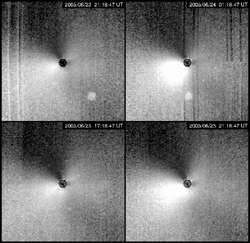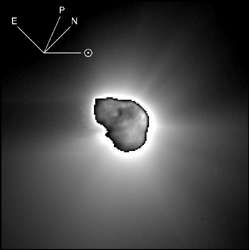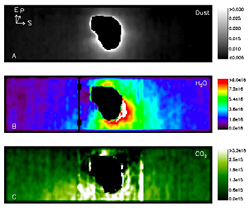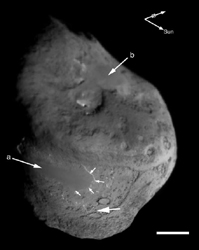EPOXI
Two intriguing investigations -- One flight-proven spacecraft
DIXI Science Objectives
DIXI Science Objectives
At the heart of NASA's Solar System Exploration endeavor is the need to understand the origins of planets, asteroids, comets and objects in the Kuiper belt. In the EPOXI mission, we are interested in both how the Solar System originated and how it is evolving. In either case we are interested in comets because we think that they tell of conditions that prevailed in the early stages of Solar System formation. They are original members of the Solar System and are little changed because they have spent most of their lives in frigid regions of the Solar System.
Observations to be made during the comet portion of the EPOXI mission are motivated largely by unexpected discoveries made during the Deep Impact mission. They are: frequent outbursts originating on the surface that radiate outward in a fanlike fashion; surface features not seen before, such as exposed edges of surface layers and relatively large flow-like features; spatial asymmetry of gasses in the inner coma; evidence for shallow penetration of solar radiation; and small patches of water ice on the surface.
In order to better understand how comets formed and evolved we will compare EPOXI observations with previous flyby observations of comets Halley, Borrelly and Wild 2 - Giotto and Vega at Halley, DS1 at Borrelly, Stardust at Wild 2, Deep Impact at Tempel 1 - looking for both similarities and differences.
The discoveries made by Deep Impact at Tempel 1 raised several new questions:
- Can the heterogeneity of gasses in the inner coma be related to the formation of the comet by the accretion of different kinds of cometesimals from different parts of the solar system?
- Do other comets show the frequent, short outbursts seen by Deep Impact at Tempel 1 and why do they happen?
- Do other comets have exposed layers and large scale flow-like features bounded by scarps? What causes them?
- Is the dark side of a comet extremely cold because heat cannot penetrate very far below the surface?
- Does the dilapidated shape of craters tell us that comets were formed earlier than previously thought?
- Does the distribution of volatiles, such as the ices of water or carbon dioxide, result from an evolutionary process or did it occur during the initial formation?
- How can we distinguish characteristics set in place during the initial formation of a comet from those that evolved later?
Outbursts
One of the significant findings made during the primary Deep Impact mission that, hopefully, will be studied during the EPOXI mission was the presence of frequent, sporadic, fan-shaped outbursts of brightness in the coma that are correlated with the comet's rotation.
This discovery is significant for the following reasons. First, outbursts of Tempel 1, unlike observations of previous comets, have been monitored continuously and at regular intervals, allowing their study as they develop. Second, outbursts of Tempel 1 were from a relatively inactive comet. Third, groups of outbursts correlate with the rotation of the comet. Fourth, the intensity rises very rapidly to its maximum, in a matter of minutes. Fifth, the outbursts often appear to emanate from localized regions on the surface.
Questions for study outbursts at Hartley 2 include the following:
- Does Hartley 2 exhibit rapidly rising outbursts?
- What is the significance of the rapid rise time?
- Do Hartley 2's outbursts, if any, correlate with local sunrise?
- Can surface features, such as the presence of ices, differences in chemical composition or topographical features, be associated with the sources of the fan-like structures?
- What processes within the comet cause the outbursts to occur?
- Does the loss of material from the outburst contribute significantly to the loss of material from the surface. If so, are there any evolutionary consequences?
Jet Activity in the Coma
During the encounter with Tempel 1, jets of material were observed spiking out from the surface of the comet. As the comet rotated, observations made from different angles enabled analysts to trace the jets to their origin on the comet's surface. Indeed, other observations show jets rising directly from the surface. Although many jets have been observed, only one weak jet seems to be associated with one of the three patches of water ice on the surface.
Interestingly enough, some jets appear to persist even though their sources are on the dark side of the comet. This phenomenon, if observed, can tell us about the thermal properties of Hartley 2's nucleus. Note that jets may have been observed coming from the dark side of comet Wild 2.
Relating The Coma To The Nucleus
The next few paragraphs, describe additional ways in which EPOXI mission scientists will study the mixture of gas and dust that surround Hartley 2's nucleus.
But first, consider the structure of a typical comet. We think of a full grown comet as consisting of three parts, a solid nucleus surrounded by a tenuous coma and attended by an also tenuous tail. Be it understood that the coma and tail are not always present. That is because a comet's orbit is very much elliptical. When the comet is near the sun its solid nucleus is heated by the rays of the sun. The nucleus is thought to be composed of a matrix of ices and dust. The ices are made mostly of water and carbon dioxide. The dust is a compound made largely of Silicon, Oxygen and various other elements such as Magnesium.
As a comet progresses along the near-sun portion of its elliptical orbit it is heated by the rays of the sun. Within the top meter or so of the surface, the heated ices turn directly from solids into gasses. The gasses expand outward, and as they do so, they drag with them the once embedded dust thus forming the tenuous coma that surrounds the nucleus.
The tail is coma material driven out toward the stars by the pressure of sunlight. There may be more than one tail or virtually none. But the EPOXI mission focuses only on the coma and nucleus.
Be it understood that when the nucleus traverses its outer orbit, it will be too cold for the ices to turn to gasses, the coma is nowhere to be seen. For this reason, most of the comet has remained in deep freeze since the early days of the Solar System - a sample of interplanetary material frozen in time.
We have already noted above the spectacular outbursts and jets observed on Tempel 1. Here we describe the more delicate features of the coma that we will seek to relate to features on the surface of the nucleus.
When examined with the spectrometer in Deep Impact's High Resolution Instrument, it was discovered that Tempel 1's coma has an excess of water vapor on its sunward side. It is most pronounced along the direction toward the sun. Further, an excess of carbon dioxide vapor was found above Tempel 1's southern hemisphere. Why these things are true is a matter for further analysis hopefully aided by observations of Hartley 2.
We would like to trace features in Hartley 2's coma to areas of heightened activity on the comet's surface. Having done so, we can entertain questions such as the following. What fraction of the dust and gas in the coma comes from active areas? What fraction of Hartley 2's area shows heightened activity? To what degree do the localized areas differ in composition? Can the differences be attributed to the presence of cometesimals that the nucleus accumulated in different parts of the Solar System as the then-forming comet migrated outward from the sun? On the other hand, differences may not be evidence of cometesimals at all, but rather they may be layered accumulations of dust and ice that solar activity has eroded at different rates because of differences in composition or because the comet's spin axis changes.
The mass of a typical comet is thought to be roughly half ice. Not all of the ice is made of water or carbon dioxide. More complex carbon-based molecules are present. In order to learn more about these ices, the coma near Hartley 2's surface will be compared spectroscopically with the coma farther out. What we hope to observe is that these complex molecules dissociate under the action of solar radiation and then, perhaps, recombine to form different molecules.
A small amount of water ice was discovered on the surface of Tempel 1 and it remains to be seen whether there is water ice on Hartley 2. If so, can it be correlated with any features in the coma?
Talps and Layers
The primary Deep Impact mission discovered surface features on Tempel 1 that shed light on the mechanisms by which, at least some, comets were formed. These features are called talps or layered piles. They consist of layers of material that are fairly large relative to the size of the comet. In high resolution images, the lower smooth flat area shows signs of flowing from left to right. Its source at the left end is in an obscure area, its right end is marked by a scarp e.g. a steep slope or cliff, some 20 meters high.
Recent theory has it that talps were laid down one after another during low speed collisions between a growing nucleus and smaller, readily deformable, objects. Further, the theory holds that there are more talps beneath the surface and that they are the "predominant building blocks" of the nucleus.
All this is thought to have happened in the earliest days of the Solar System while comets were still forming. Therefore, we say that the material is pristine. On the other hand, the scarps are thought to have formed later by the erosive effect of volatile material escaping from the nucleus after having been turned from ice to gas by the heat of the sun.
Be it noted that there is some evidence of layering and smooth flowlike areas on other comets. For example, layering in both Borrelly and Wild 2 and the suggestion of smooth flowlike areas on Borrelly.
The flat areas are theorized to be composed of a powdery substance. Some layers are seen edge on. Up to seven layers have been identified in the region just above and to the right of the large flat area.

 Halley
Halley Borrelly
Borrelly Wild 2
Wild 2 Tempel 1
Tempel 1


